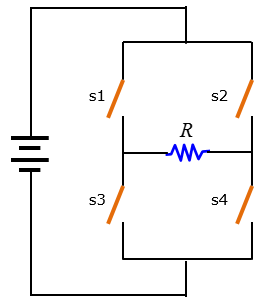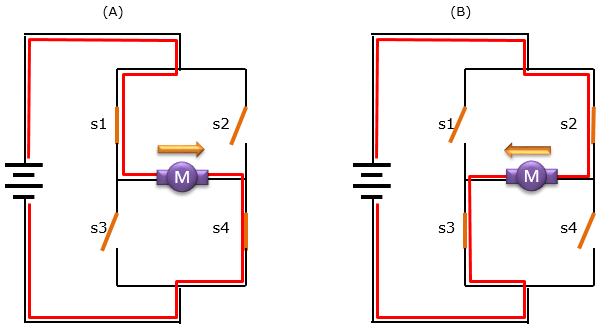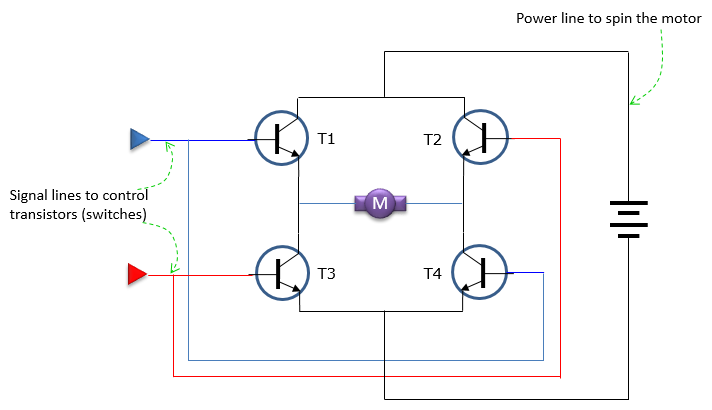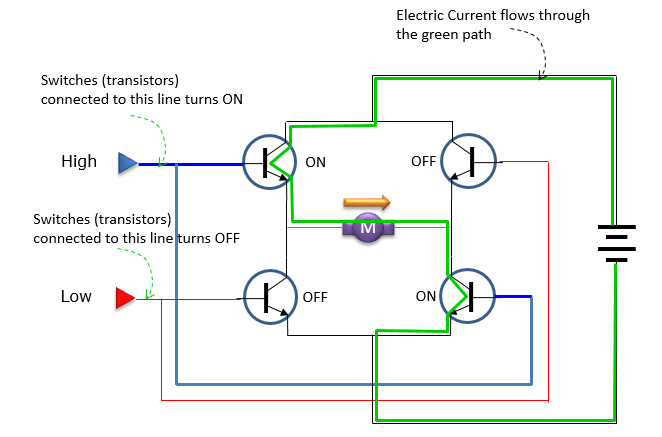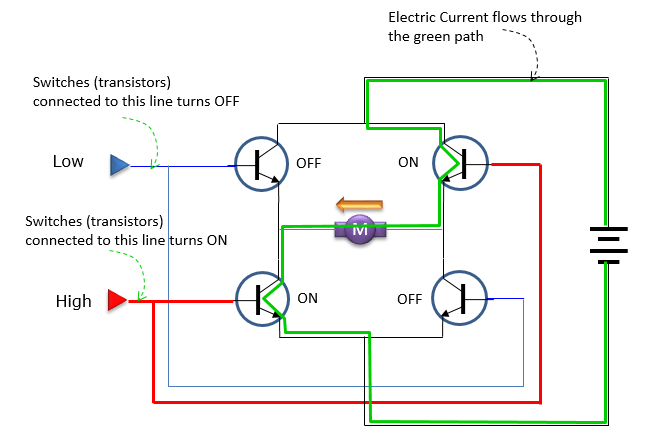|
Electronics |
||
|
H-Bridge
H-Bridge is one of the most important parts of DC motor control circuit. It is a device that enable you to change the direction of the motor spin by altering the direction of current flow in the motor. The device is simply a circuit that has 4 switches connected in series loop and a motor that is connected across the series, which forms an "H-Shaped" circuit , hence the name H-Bridge. Putting it in super simple manner, it can be illustrated as below. By putting the four switches on/off in a specific combination, you can change the direction of the current flowing through the register R. Just try to think on your own about which switches should be ON and which switches should be OFF if you want to flow the current left to right through R. and to think on your own about which switches should be ON and which switches should be OFF if you want to flow the current right to left through R. If you can get the right answer to these questions, you don't have to read any further since you already know the logics of H-bridge.
If you don't have your own answer, take a look at the following example. In (A), the switch s1(Top Left) and s4(Right Bottom) is closed (ON), and s2(Top Right) and s3(Left Bottom) is Open (OFF). In this case, the electrical current flows along the path indicated by the Red line. If you check the direction of the current at the resistor R, you would notice the direction is 'Left to Right'. In (B), the switch s2(Top Right) and s3(Left Bottom) is closed (ON), and s2(Top Right) and s4(Right Bottom) is Open (OFF). In this case, the electrical current flows along the path indicated by the Red line. If you check the direction of the current at the resistor R, you would notice the direction is 'Right to Left'.
In case of Resistor as in the example above, it doesn't matter much whether the current flows 'left to right' or 'right to left'. But if you put a specific device like DC Motor as in the following example, the direction of the current flow really matters because the direction of the current determines the direction of the Motor spin. If the DC motor is connected to wheels of a car, the direction of the current will determine the direction of car movement (moving forward or moving backward).
If you recall on how the four switches goes on and off to change the direction of the current, you might have noticed a certain pattern. The patterns is that the two switches along the diagonal line (e.g, s1 & s4 and s2 & s3) closes/opens in the same mannor. If you have a common electronics knowlege, you may understand we can build this kind of switching circuit using four transistors and two signal lines as shown below. (If you are not familiar with the transiter, refer to Transistor page)
Now let's think of the case where the blue signal path is supplied with HIGH signal. As you see in the following illustration, T1 and T4 transistor gets ON, and T2 and T3 transistor goes OFF. As a result, the current from the battery will flow as indicated by the green path. If you follow through the green path, you would notice that the current flow though the motor from left to right.
Now let's think of another case where the red signal path is supplied with HIGH signal. As you see in the following illustration, T2 and T3 transistor gets ON, and T1 and T4 transistor goes OFF. As a result, the current from the battery will flow as indicated by the green path. If you follow through the green path, you would notice that the current flow though the motor from left to right.
If you combined the logic of the two cases described above, you would (hopefully) get some intuitions on how H brige works and how it can be built by using 4 transistors.
Afterall, H-Bridge is a circuit that controls direction of the current at a certain device (e.g, an electric motor) by switching pattern of 4 switches. If you enjoy building circuits and have plenty of time to do so, definitely try to build one! If you want to challenge yourself above and beyond, try to add protective features onto the circuit. This will enhance your research and problem solving skills and is a great opportunity to apply what you have learned in the classroom as an engineering student. If you just want to spend too much time and effort on building the circuit on your own, you can easily purchase a ready-made H-Bridge. However, regardless of whether you build the circuit on your own or purchase a ready-made component, it is always recommended to understand the internal mechanism first before you try anything.
|
||
